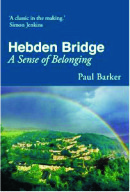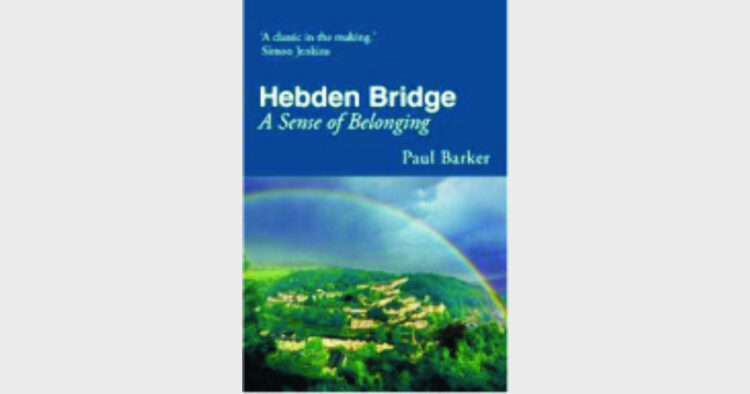Manju Gupta
 Hebden Bridge: A Sense of Belonging, Paul Barker, Frances Lincoln Limited Publishers, Pp 205, £ 16.99
Hebden Bridge: A Sense of Belonging, Paul Barker, Frances Lincoln Limited Publishers, Pp 205, £ 16.99
This book is an exploration of Hebden Bridge lying in the upper Calder valley and tucked between Halifax and the Lancashire border and which became famous during the Industrial Revolution for its mills that spun cloth, encouraging the surrounding villages to turn the cloth into cheap ready-made clothing. The book takes you on a journey by the author to a region where he was born and which he visits after a long period to refresh his memories of it.
Since then, Hebden Bridge has made the transition from the Yorkshire Pennines’ traditional economy of textiles-plus-farming to a town – many could call it a large village that now thrives as a home for arts and crafts. Hebden Bridge has seen a social change from the 1970s with the working class becoming mostly middle class. This shows a high percentage of energy and adaptability of the locals.
The transition was, however, accompanied by conflicts between “offcomers”, who delighted in the idea of a “community” and the established community itself. There were battles between squatters and the advocates of establishing supposedly-outdated housing. In the late 1960s, the textile business collapsed – the spinning, the weaving, the dyeing, the sewing shops for the ready-made trade. This was partly due to cheaper goods from abroad and partly due to Labour government’s obsession to bring small textile firms together into larger conglomerates. Decline set in, houses fell empty and shops closed. It became brass band country where cornet was now played with drums and carols were sung at Christmas.
The author talks of the frequent fires that afflicted Hebden Bridge as there were plenty of mills which caught fire easily, giving first to the suspicion that failing firms got rid of their buildings to claim the insurance; of the people with special characteristics living in Hebden Bridge, of his friendship with Lady Willie known for his restaurant and his addresses from the local pulpits; about Chris Ratcliffe, one of the original Hebden ‘hippies’; of Christine Jackson, clever and shrewd, who sees people “come and go. Hebden Bridge goes on”; of his own ancestors who were of Polish origin; of the ‘offcomers’ or newcomers; about the Zion Chapel; of Edmund Ashworth who became Lance-Corporal and was a bowler for the local cricket team; about the Stoodley Pike – a memorial erected to peace, not war to celebrate Napoleon’s defeat in 1814 at the Leipzig ‘Battle of the Nations’; of Michael Silcock (‘Silly) who loved getting drunk, who went for de-toxing and returned to getting drunk; of Slack Chapel overlooking the cemetery; his own house on No. 6, Erringden Road; about his ancestors and their lifestyle; about his school at Mytholmroyd, the market place; of his dreams about Hebden which no longer has working class people and who prefer a bike to a car, wanting to live in former industrial or commercial settings.
There are references to India too in the book – one to Halifax, which is a Kashmiri colony and to Lane Ends from where “Indian dishes are brought in specially from an award-winning restaurant three or four miles away.
(Frances Lincoln Ltd, 4, Torriano Mews, Torriano Avenue, London NW5 2RZ, www.franceslincoln.com)
Need for tact in a complex world
Manju Gupta
The Spirit of Compromise, Amy Gutmann and Dennis Thompson, Princeton University Press, Pp 279, £ 16.95
The theme of the book is the need for compromise in a democracy and the authors admit that though compromise is not easy, governing a democracy without compromise is impossible. They cite the example of 2011, when in Washington, DC, a sharply divided Congress confronted the need to raise the sovereign debt limit of the US. With the approach of the August 3 deadline, the fear of a financial crisis loomed large but on 31 July, US President Barack Obama announced that both the House and the Senate had reached an agreement. Yet criticism of the compromise abounded on all sides.
Why is compromise so hard in a democracy even when it is necessary? The authors say that much of the resistance to compromise lies in another necessary part of the democratic process: campaigning for political office. Though valuable in its place, campaigning is increasingly intruding into governing, where it is less helpful. The means of winning an office are subverting the ends of governing once in office. The effects of a continuous campaign, along with the distorting influence of media and money that it brings, encourage a mindset among politicians that make compromise more difficult. To sum it in one sentence, “Systematic rejection of compromise is a problem for any democracy because it biases the political process in favour of the status quo and stands in the way of desirable change.”
The authors say that the resistance to democratic compromise is anchored in what is called an uncompromising mindset, a cluster of attitudes and arguments that encourage standing on principles and mistrusting opponents. This mindset is conducive to campaigning but inimical to governing. Resistance to democratic compromise can be kept in check by compromising the mindset, which favours adapting one’s principles and respecting one’s opponents.
It is the mindset which is more appropriate for governing because it enables politicians more readily to recognise opportunities for desirable compromise. “When politicians adopt it, enough of the time, the spirit of compromise prevails,” claim the authors.
The unfortunate part of it all is that politicians complain about the decline of the spirit of compromise, but they have not seen it fit to restrain the clamour of campaigning. The authors complain that political scientists have exposed the harmful consequences of misplaced campaigning, but they have not connected this problem with these mindsets and their implications for a democratic compromise. Understanding the mindset can help show how the tension between campaigning and governing creates difficulties for compromise and how a better balance between campaigning and governing supports possibilities for a compromise.
If politics is the art of the possible, compromise is the artistry of democracy. Democracy calls on politicians to resist compromise and to accept it. They may resist it when they campaign but they need to accept it more when they govern. The mindset that the campaign demands – standing tenaciously on principles and mistrusting opponents – gets in the way of negotiating the deals required to pass laws in a pluralist society.
(Princeton University Press, 41, William Street, Princeton, New Jersey – 08540)
A haunting tale of espionage
Manju Gupta
The Interrogator: An Education, Glenn L Carle, Nation Books, Pp 321, £ 26.99
Here is a haunting tale of sadness, confusion and detention, providing an intimate look at the world of espionage.
Carle, who retired in 2007 after 23 years as a member of the CIA’s clandestine service, recounts his toughest assignment when he was ‘surged’ to interrogate a top-level al-Qaeda detainee at two different black sites overseas. It tells of his encounter with one of the most senior al-Qaeda detainees in the US.
To his friends, Glenn was a stereotypical New England Yankee, a former athlete with his nose in an abstruse book. For two decades he broke laws, stole and lied on a daily basis about nearly everything. “I was almost never who I said I was, or did what I claimed to be doing.” He was a CIA spy, thriving in an environment of duplicity and ambiguity.
This book is a confession of this former US Government operative who spent almost two decades working undercover and was charged with interrogating one of the highest high profile al-Qaeda detainees since 9/11.
In this book, Carle captures the spirit of the CIA – bureaucracy, dedication and machismo – in a voice that manages to be descriptive, analytical, reflective and philosophical in turns. The narrative raises the importance and questions about the policies of the CIA and the US Government as they go about accelerating their war against terrorism.
(Nation Books, 116, East 16th Street, 8th Floor, New York, NY-10003)
A fascinating account of migration of animals and birds
Manju Gupta
Nature’s Compass: The Mystery of Animal Navigation, James L Gould, Carol Grant Gould, Princeton University Press, Pp 294, £19.95
This book is on animal navigation and migration. Man has always been perturbed about animal compasses and maps and how animals use time and decode the critical roles of early rearing, juvenile experience and ongoing adult recalibration.
Migration of animals has always been a mystery with them appearing unexpectedly and vanishing again, en route from an unidentified home to an unknown destination. How incredible it is that the tiny hummingbirds would have journeyed more than 1,500 miles for the brief summer while the fragile monarch butterflies preparing themselves for a 2,000-mile trip south in the Fall. Yet, for them and a myriad other species, it is perfectly routine for most animals for which even local navigation is a common and crucial activity and who are performing feats far beyond anything humans can manage without specialised instruments, equipment and training. What they know innately about the sun and the sky can shock humans. Creatures are making use of the sun and stars, polarised light and colour gradients, endogenous timers (daily, tidal, lunar and annual), landmark memory and cognitive maps, magnetic fields, extrapolated gradients and more to chart their route.
Of late, the threat of climate change and the ensuing change in global habitats have been concerns for decades. While many species have the inherent capacity to accommodate climate change, the more serious threat for most is habitat destruction. More than 40 per cent of endangered birds are in this category because of habitat loss. The authors say that by far the biggest victims of habitat destruction are the shore-birds: the rich wetlands’ environment that is life to them and so many other creatures is valuable coastal real estate to humans. The “reclamation” of marshes and mangroves, the damming of streams and pollutions of bays and rives has reduced shorebird habitat drastically.
The research by the authors reveals that the past quarter century has witnessed a general and ever-increasing pattern of disruption in migratory paths and behaviour – a disruption largely attributable to human activities and global climate change. The twin threats of habitat loss and climate destabilisation that enables migration might now be leading migratory animals to oblivion. The authors feel that for certain high-risk species, an increasing understanding of animal navigation could provide the key to effective conservation efforts.
(Princeton University Press, 41, William Street, Princeton, New Jersey – 08540.)













Comments